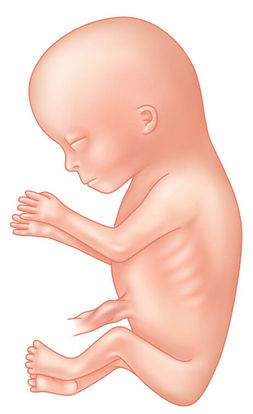11 weeks and 7 days pregnant

Here the legs are crossed and the arms outstretched. The umbilical cord is short and thick at this stage, but will lengthen as the baby grows, and become much thinner with many coils.
You’ve reached the end of the first trimester and in this time your baby has developed from a ball of cells to an active fetus.
Your amazing baby can do so many things already, including being able to open her mouth and yawn, and swallow. Swallowing develops earlier than sucking. Your baby will be starting to swallow amniotic fluid but the more complex sucking movements cannot be identified until 18–20 weeks. Swallowing will encourage gut development. The amniotic fluid enters into the stomach not the lungs, which are protected now by the vocal cords and the higher pressure of the lung’s own fluid. The amniotic fluid will later be excreted as urine when the fetal kidneys start to function.
After the stomach, the amniotic fluid will enter the small bowel. The intestinal walls are developing muscular layers but these do not yet contract in a co-ordinated way to move the fluid along the digestive tract. It will be 20 weeks before the structural organization of the gut is finally complete. Many digestive enzymes are starting to be released into the gut but these currently act as a stimulus to development rather than for the absorption of nutrients.
Your baby is reliant on a steady stream of glucose, which is stored as glycogen in the liver. This continues throughout pregnancy and at birth your baby will, for her size, have significantly larger glycogen stores than adults do. The correct level of glucose in the mother is controlled by insulin secreted by the pancreas. The placenta, however, has little control over the amount it takes from your bloodstream and passes on. For this reason if your glucose level is very high, for example in poorly controlled diabetes, the baby will have high levels of glucose. To maintain a normal glucose level she will secrete insulin, but this will lead to increased fat deposition and weight gain.
Most women develop a good relationship with their midwife, who can be a fountain of fantastic information, and a wonderful source of comfort and reassurance.
It’s important that you are as honest as you can be with her. Like many women, you may be reluctant to reveal concerns, or to admit to unhealthy habits, for fear of being embarrassed or told off. It’s very likely that your midwife will have heard it all before, and will be able to help and advise – and make a few tried-and-tested suggestions.

At 12 weeks your baby’s crown to rump length is 5.4cm (2.1in).

9 weeks

12 weeks

All your baby’s organs, limbs, and facial features are in place, but her head is still disproportionately large. She can open and close her mouth, and her eyes are developing behind closed lids.
Be the first to support
Be the first to share
Comment (0)
Related Blogs & Vlogs
No related events found.
Loading more...